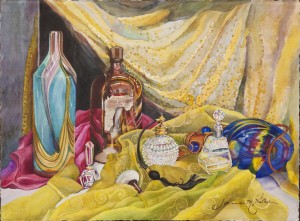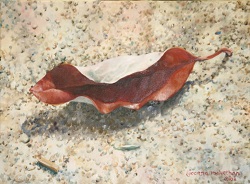JOANNA MCKETHAN EXHIBITS IN
WSNC 1st SIGNATURE MEMBER SHOW
Watercolor Society of North Carolina Presents
at CCA, Kinston, in their Hampton Gallery
March 28 – June 23, 2012
In an invitational exhibit sponsored by the Watercolor Society of North Carolina for its signature members, Joanna McKethan, SW, WSNC, exhibited two watercolor paintings to hang with the organization in the Hampton Gallery of the CCA in Kinston, from March 28-June 23rd, 2012. The Kinston facility is one of the largest galleries in the state.
Celebrated as the “best of the best,” The Arts Center at 400 North Queen Street in Kinston held the WSNC’s Signature Members’ Exhibit. With its inaugural showing, the society hopes to encourage more watercolorists to join the organization to reach this level of achievement.
The WSNC has approximately 100 Signature Members, all of whom were invited to participate without restriction on the year of execution of their work. They were restricted to work done in water media only.
WSNC is a non-profit art organization whose purpose is to promote watercolor throughout the state and to elevate the standards of excellence in this medium.
A “signature member” has achieved a status which allows the awarded member to use the initials of the accrediting society after his or her name in all advertisements of their painting credentials. Signature membership status is awarded by painting organizations using differing standards to qualify members who excel in one way or another.
WSNC’s excellence guidelines are, as quoted in their brochure, “WSNC Signature Membership is merited by members who win two first through fifth place awards in two separate annual statewide WSNC exhibitions after February 1999.” Since 2002, the status may also be obtained by acceptance of an artist’s entry into three separate annual statewide WSNC exhibitions. Once an artist has begun qualification under either method, “membership in WSNC and payment of annual dues must be continuous to be eligible for and retain Signature Membership status.”
Only Signature Members are entitled to use the initials “WSNC” after their names.
Joanna McKethan, SW, WSNC, had two paintings hang in the Kinston show, the “WSNC Signature Members Exhibit.”
Her full sheet painting, “Paper Trail,” in yellows, pinks, and antique golds, is a trompe l’oeil painted like a collage of gathered letters from loved ones in the poignant past, assembled in random style. Hand-made papers bear holes in them, and other still-life memorabilia of age accompany them. The written words are only partially readable, some showing through the holes; some unhindered.
Painted versions of fallen leaves and seedpods are strewn through the old letters randomly, influenced as much by chiaroscuro as possible to render them lifelike, as though you could pick them up.
An artist friend’s tiny paper booklets were models used in painting, as well. She met this friend at the artist’s retreat at Mt. St. Francis in Indiana, for two weeks over five summers, completing works of art. Some of their working concepts overlapped, in symbols of leaf on leaf and pages from books. Mt. St. Francis no longer uses its house or artist’s center for invited artists with the arts council.
“Paper Trail” was shown in the Southern Watercolor Society’s show, the SW being a regional watercolor society in the Southeast, 18 states including Washington, D.C., of which Ms. McKethan is also a signature member.
The rivulets of color represent the passage of life, the seasons; the stamped letters are destinations reached. Ancestors who found each other who became bearers of my life, the overlapping pages indicate links in generational chains. The leaves are scarred by their journey, with ragged edges like the edges of handmade (deckled) paper. The paper with its holes and stains is folded in ways of happenstance, as when the reader, perhaps in a hurry, creased the paper to fit it into a book to save. Though it bears the marks of rough handling, it is intact, sturdy, and still pliable.
Totally transparent watercolor in a collage style is one of the recurring threads in Ms. McKethan’s work, represented in her second piece as well, “A Rose Is a Rose,” which has a photograph of her mother, and a single rose laid over that ’photograph’ which rests beside the old, stained, handwritten letters.
Created entirely with paint, the theme is melancholic and depicts the artist’s mother before she was married. Layering is a favored technique used by Ms. McKethan. A difficult art, she says, since you must leave portions of the paper free of color, all the way down to the very first washes. For vibrancy, she avoids flushing the paper with all three primary colors, since that produces a grey undertone. She leaves out blue for the light side, utilizing only gold-toned colors, while the dark side which must contain the blue (and less yellow, except for making green). This sharpens contrast when the two meet, and allows the light side to emerge much more brightly.
“People forget that grey forms immediately when you have all three colors,” she confides a teaching secret with us. “Used well, one avoids mixing mud, but used poorly, all the colors look alike or end up tired and muddy, producing an inferior watercolor.”
Particularities were disguised enough to make the pieces tell anyone’s story. Other similar works bear exact personal information. Collectors do not seem to mind possessing paintings with names outside their own families.
“In a sense my history becomes yours when you acquire the painting,” the artist says, “and the threads of history are passed on.”
”The only bad watercolors are those which are tired (overworked) and too thirsty (dry),” said my Polish watercolor teacher in Munich, Germany, who taught me classical techniques of watercolor at the outset.
And I agree with him whole-heartedly.
“Mud is just a bad brown. Mixing all three primary colors produces a neutral—either a warm or a cold neutral—brown or black, tan or grey. Show me your mud, and I can diagnose what color you need to add to pull it out of the mud-puddle and bounce it back in any color direction you want it to go. Stick with me and I’ll teach you my color system, which fool proofs you from mud.”
And then it will leave a lovely color trail on paper.
Learn more »

